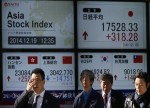
- All Instrument Types
- Indices
- Equities
- ETFs
- Funds
- Commodities
- Currencies
- Crypto
- Bonds
- Certificates
Please try another search

Bet On Low-Beta ETFs In An Uncertain Market

The coronavirus outbreak has taken a toll on economic activities across the globe, leading to suspension of professional sports games, cancelation of major events, conferences and conventions; prohibition of mass gatherings, travel bans and half-empty restaurants. This has been hurting many corners of the market, resulting in a broad market sell-off (read: Coronavirus Panic to Send Economy Into Recession: ETF Picks).
The number of coronavirus cases climbed above 236,000 globally per the latest data, including more than 11,000 in the United States. Economists predict a surge in joblessness and slump in consumer spending that will deal a heavy blow to the previously booming U.S. labor market and services economy. Given the pandemic, market participants forecast global recession.
Meanwhile, the oil industry has been suffering the worst rout in many years. Oil price has been in a freefall on a combination of excess supply and shrinking demand. In fact, U.S. crude dropped below $25 per barrel for the first time. With the latest plunge, oil price is down 60% so far this year (read: Oil & ETFs: What Investors Need to Know).
However, central banks across the globe have stepped up their efforts to protect the economy from the fallout of the deadly coronavirus. Though they are unable to re-instill confidence in the market currently, they could set the stage for faster recovery.
Against such a backdrop, investors seeking to remain invested in the equity world could consider low beta ETFs.
Why Low Beta?
Beta measures the price volatility of stocks relative to the overall market. It has direct relationship to market movements. A beta of 1 indicates that the price of the stock or fund tends to move with the broader market. A beta of more than 1 indicates that the price tends to move higher than the broader market and is extremely volatile while a beta of less than 1 indicates that the price of the stock or fund is less volatile than the market.
That said, low-beta products exhibit greater levels of stability than their market-sensitive counterparts and will usually lose less when the market is crumbling. Given lesser risks and lower returns, these are considered safe and resilient amid uncertainty. However, when markets soar, these low-beta funds experience lesser gains than the broader market counterparts and thus lag their peers.
Below we have highlighted five ETFs that could be intriguing options for investors amid the coronavirus-led market turmoil. These funds do not track a particular sector or industry but are instead exposed to broader market risk and reward. All these have AUM of more than $50 million, indicating good tradability.
First Trust Dorsey Wright Momentum & Low Volatility ETF (BS:DVOL) – Beta: 0.55
This ETF tracks the Dorsey Wright Momentum Plus Low Volatility Index, which measures the performance of 50 stocks within the NASDAQ US Large Mid Cap Index that exhibit the lowest levels of volatility while maintaining high levels of relative strength. The fund has AUM of $89.5 million and charges 60 bps in annual fees. Average trading volume is good at 81,000 shares.
Global X SuperDividend U.S. ETF (TSX:DIV) – Beta: 0.59
This fund provides exposure to 50 highest-dividend-yielding U.S. securities by tracking the INDXX SuperDividend U.S. Low Volatility Index. The product has amassed $301.4 million in its asset base while trading in moderate volume of about 208,000 shares. It charges 46 bps in fees per year from investors and has a Zacks ETF Rank #3 (Hold) with a Medium risk outlook (read: High Yield Dividend ETFs & Stocks to Buy as Fed Cuts Rate).
Invesco S&P 500 Low Volatility ETF SPLV – Beta: 0.60
This ETF provides exposure to stocks with the lowest-realized volatility over the past 12 months. It tracks the S&P 500 Low Volatility Index and holds 100 securities in its basket. The fund has amassed $9.2 billion in its asset base and trades in heavy volume of nearly 4.5 million shares a day on average. It charges 25 bps in annual fees and has a Zacks ETF Rank #3 with a Medium risk outlook (read: Do Low Volatility ETFs Outperform During Market Turmoil?).
First Trust Horizon Managed Volatility Domestic ETF HUSV – Beta: 0.62
HUSV is an actively managed ETF, providing exposure to 127 domestic stocks that seem to exhibit low future expected volatility. It has amassed $177.3 million in its asset base but sees lower average daily volume of 67,000 shares. Expense ratio comes in at 0.70%.
Legg Mason Low Volatility High Dividend ETF LVHD – Beta: 0.63
This fund provides exposure to 82 U.S. companies with a relatively high yield, low price and earnings volatility by tracking the QS Low Volatility High Dividend Index. The ETF has $657.5 million in AUM and trades in moderate volume of 154,000 shares. It charges 27 bps in fees and has a Zacks ETF Rank #3.
Bottom Line
Investors should note that these products are not meant for generating outsized returns. Instead, these provide stability to the portfolio, protecting the initial investment. In particular, these products could be worthwhile for low risk-tolerant investors looking to safeguard their portfolio in the current market environment and seeking outperformance.
Want key ETF info delivered straight to your inbox?
Zacks’ free Fund Newsletter will brief you on top news and analysis, as well as top-performing ETFs, each week. Get it free >>
Global X SuperDividend U.S. ETF (DIV): ETF Research Reports
Legg Mason Low Volatility High Dividend ETF (LVHD): ETF Research Reports
Invesco S&P 500 Low Volatility ETF (SPLV): ETF Research Reports
First Trust Horizon Managed Volatility Domestic ETF (HUSV): ETF Research Reports
First Trust Dorsey Wright Momentum & Low Volatility ETF (DVOL): ETF Research Reports
Original post
Zacks Investment Research
Related Articles

Since the Robotaxi event on October 11th, Tesla (NASDAQ:TSLA) stock is up 38%, currently priced at $291.60 per share This is a return to the early November 2024 price level. But...

The Q4 2024 earnings season tapers off from here, with S&P 500® EPS growth surpassing 17%, the highest in 3 years Large cap outlier earnings dates this week include:...

Shares of Alibaba (NYSE:BABA) are on a tear to start off 2025. The consumer discretionary and tech stock is up by 52% this year as of the Feb. 25 close. The company’s cloud...
Are you sure you want to block %USER_NAME%?
By doing so, you and %USER_NAME% will not be able to see any of each other's Investing.com's posts.
%USER_NAME% was successfully added to your Block List
Since you’ve just unblocked this person, you must wait 48 hours before renewing the block.
I feel that this comment is:
Thank You!
Your report has been sent to our moderators for review





Add a Comment
We encourage you to use comments to engage with other users, share your perspective and ask questions of authors and each other. However, in order to maintain the high level of discourse we’ve all come to value and expect, please keep the following criteria in mind:
Enrich the conversation, don’t trash it.
Stay focused and on track. Only post material that’s relevant to the topic being discussed.
Be respectful. Even negative opinions can be framed positively and diplomatically. Avoid profanity, slander or personal attacks directed at an author or another user. Racism, sexism and other forms of discrimination will not be tolerated.
Perpetrators of spam or abuse will be deleted from the site and prohibited from future registration at Investing.com’s discretion.